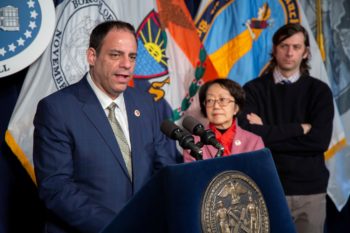
Council Members Constantinides, Chin, and Levin speak at the Pre-Stated Conference on January 23, 2020, prior to the passage of their lead bills. Council Member Ritchie Torres (not pictured) also sponsored a bill for investigations of lead-based paint hazards. Image Credit: Official NYC Council Photo by John McCarten
One bill would require the results of Department of Education school inspections to be made public and distributed to parents and guardians. On January 23, 2020, the City Council voted to approve legislation to strengthen existing lead laws. While lead paint was banned in the 1960s, its use in buildings constructed prior to the ban still negatively impacts New Yorkers. Particularly, children who are affected by lead paint may have lifelong impairments. In 2018, nearly four thousand children were identified as having elevated lead levels.
In 2019, City Council passed the Childhood Lead Poisoning Prevention Act, which was ten pieces of lead-related legislation designed to ensure the City met federally recommended standards for lead testing, improving lead education and lead investigation and remediation requirements. The most recent bills passed this year will further strengthen the Childhood Lead Poisoning Prevention Act.
The new bills cover a variety of areas, from schools to dwelling to inspections. Some of the bills passed include the following:
Introduction No. 891-A, sponsored by Council Member Stephen T. Levin, amends the City administrative code in relation to lead poisoning prevention and control in certain dwellings. The bill expands the meaning of “multiple dwelling” in lead laws to include private dwellings where at least one unit that is not owner-occupied. Previously, the requirements to investigate and remediate lead hazards in dwellings only applied to multiple dwellings, excluding certain smaller buildings where residents may still be at risk of lead exposure.
Introduction No. 919-A, sponsored by Council Member Ritchie J. Torres, amends the administrative code to require investigations of lead-based paint hazards by independent and certified inspectors, and contractor certifications for construction activities that disturb lead-based paint. The bill requires that, within five years of the bill’s effective date or one year of a child moving in, a thorough inspection of a dwelling unit must be conducted by an EPA-certified inspector and include a specified inspection protocol. It would also require home improvement contractors to show that they are EPA-certified to ensure that they are prepared to follow lead-based paint related safety standards.
Introduction No. 873-A, sponsored by Council Member Margaret Chin, requires the Department of Education schools to conduct regular inspections to lead-based paint hazards in certain spaces. The results of such findings will be made publicly available and sent to parents and guardians. This bill would also require Housing Preservation and Development, when conducting certain inspections, to determine whether there has been a violation of the requirement to remediate lead hazards when a unit turns over. Further, it would establish a presumption that a building owner who is unable to provide a record of having remediated lead hazards at turnover has violated the requirement to do so.
Introduction 420-B, sponsored by Council Member Costa Constantinides, requires the Parks Department to test for lead concentration levels in areas of parks under Parks’ jurisdiction that contain exposed soil and are used for active play or passive recreation whenever a capital project occurs in such area. If the test finds that a bare soil area has a lead level at or above the level set forth in title 40 of the code of federal regulations, Parks must cover, replace or otherwise remediate the area.
City Council Speaker Corey Johnson stated, “New Yorkers should not have to worry about lead poisoning in their children, which can create devastating lifelong problems. The City Council takes lead exposure very seriously and is proud to improve the Childhood Lead Poisoning Prevention Act to better protect families from the impact of lead.”
Mayor Bill de Blasio signed the bills into law on February 11, 2020.
By: Laine Vitkevich (Laine is a CityLaw Intern and New York Law School student, Class of 2020)


Lead damages many organs, and the damage to the developing brain can be lifelong. Researches have shown that lead contains paints of various, including well-known, manufacturers. So only in 5 out of 21 prototypes the level of lead did not exceed the maximum recommended indicator of 0.009%. A new law has been passed for builders and repairman in New York, the EPA requires the RRP Lead Renovator Initial Course https://www.ablesafety.com/course/8-hour-epa-rrp-lead-safe-certified-renovator-initial-blended is mandatory and must be passed by the end of the year. It contains a hands-on training component, therefore the majority of the class may be done online (6 Hours) but participants will still be required to attend a small portion to participate in the hands-on activities (2 Hours)